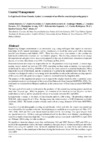Identificador persistente para citar o vincular este elemento:
https://accedacris.ulpgc.es/jspui/handle/10553/114710
| Título: | La Laja beach (Gran Canaria, Spain): An example of an effective coastal engineering project | Autores/as: | Melián Ramírez, Abisai Suárez González, E. Santos Bethencourt, R. Santiago Villalba, J. Masdeu Navarro, M. Hernández Acosta, C.N. Echevarrieta Legrand, L. Castro Rodríguez, M. A. Sánchez García, María José Alonso Bilbao, Ignacio |
Clasificación UNESCO: | 2510 Oceanografía 251010 Procesos litorales o sublitorales 330537 Planificación urbana |
Fecha de publicación: | 2014 | Conferencia: | IV Congress of Marine Sciences | Resumen: | Engineering changes environment in an irrevocable way, using techniques that require an extensive knowledge of the natural environment and its constituents, to reach the onset goals with a minimum possible cost (Montoya and Galofré, 1997). There have been many interventions in the coastline for both beach stabilization structures and nourishment projects. The resulting construction is not always the expected one and quite often it needs to be repaired (in the case of stabilization structures) or repeated (in case of periodic fills) (Serra et al, 1991; Flor-Blanco & Flor, 2011). Direccio´n General de Costas was responsible for the ”Regeneration of La Laja beach”, a coastal engi- neering project carried out between 1991-1993, consisting on three main actuations: the regeneration of the beach by means of filling 400000 m3 of sand, the construction of a detached breakwater 140 m long in the middle of the beach, and the construction of a groin in the southern end of the beach. First structure was designed to reduce wave energy in its lee and thus to reduce the sediment carrying capacity of the waves, while the groin was designed to prevent sediment losses by longshore drift. The purpose of this regeneration project was to expand the original beach in order to promote a new recreational area in the southern part of the town of Las Palmas de Gran Canaria (MOPTMA, 1993). The used sand was extracted from Malpaso sandbank, in the eastern coast of Gran Canaria island (MOPTMA, 1993). The main goal of this study is to determine the goodness of this coastal engineering project carried out more than 20 years ago. With this purpose, the evolution of the beach in the last 50 years has been established, as well as and its variation in volume of sediments between 2012 and 2014. La Laja beach is located in the island of Gran Canaria and it is 1200 m long. The prevailing winds are NNE-NE, with average Hs of 1.19 m. During storms the wind direction is E-SE (Ministerio de Medio Ambiente, 2002). The beach contains volcanic sand with an average diameter of 0.4 mm (MOPTMA, 1989). A number of aerial photographs covering several decades before and after the project was carried out were selected for the coastline evolution. Aerial photographs available at www.grafcan.es of 1966, 1975, 1987, 1998, 2005 and 2011 were chosen based on three criteria: tide setting; time span between them and spacial resolution. All them were georreferenced and the shorelines were obtained considering the water lever marks of previous high tide. Two topographic surveys were made with DGPS in April 2012 and February 2014 during low tide conditions. No significant shoreline changes were observed between 1966 and 1987. Between 1987 and 1998, as a result of the regeneration project, the beach completely changed, since it become much larger and wider. Particularly along the southern zone, the beach amplitude increased by some 30 m, and a salient was naturally formed in the central part of the beach facing the breakwater. Since 1998 the coastline is again very stable. High resolution topographic data from the foreshore al the backshore shows a small increase in sand volume of 287 m3 between 2012 and 2014. This value is so small that it indicates sedimentary stability along the beach. Nevertheless, some movement of sediment has been detected, so that there is a certain erosion along the foreshore and in the southern part of the beach, while the accumulation mostly takes place in the upper beach. La Laja beach has a shoreline that remains stable both before and after the regeneration. This result from the aerial photographs analysis in the long term is supported by the DGPS measurements in the short term. This sedimentary stability is normal in closed systems with no sediment inputs nor outputs. This is due to its location between one protruding rock in the north and the groin located in the southern end preventing the sediment loss from the beach. The current state of equilibrium is based on the properly (the detached breakwater and the south groin) that prevent sediment losses. | URI: | https://accedacris.ulpgc.es/handle/10553/114710 | ISBN: | 84-697-0471-0 | Fuente: | Book of Abstracts submitted to the IV Congress of Marine Sciences. Las Palmas de Gran Canaria, June 11th to 13th 2014, p.p. 436-437 |
| Colección: | Póster de congreso |
Visitas
35
actualizado el 27-abr-2024
Descargas
15
actualizado el 27-abr-2024
Google ScholarTM
Verifica
Altmetric
Comparte
Exporta metadatos
Los elementos en ULPGC accedaCRIS están protegidos por derechos de autor con todos los derechos reservados, a menos que se indique lo contrario.
